suspension Alfa Romeo MiTo 2012 Owner handbook (in English)
[x] Cancel search | Manufacturer: ALFA ROMEO, Model Year: 2012, Model line: MiTo, Model: Alfa Romeo MiTo 2012Pages: 262, PDF Size: 6.46 MB
Page 7 of 262

6GETTING TO KNOW YOUR CAR
Interior fittings...................................................................................... 89
Electric sunroof ..................................................................................... 92
Doors .................................................................................................. 95
Electric windows................................................................................... 96
Luggage compartment........................................................................... 99
Bonnet................................................................................................ 103
Roof rack/ski rack ................................................................................ 104
Headlights ........................................................................................... 105
ABS system ......................................................................................... 107
VDC system ......................................................................................... 108
“Alfa DNA” system................................................................................. 111
Start&Stop system ................................................................................ 114
Dynamic Suspension.............................................................................. 119
EOBD system ....................................................................................... 120
Electric power steering ........................................................................... 120
Radio wiring system .............................................................................. 121
Wiring for navigation system................................................................... 122
Installation of electrical/electronic devices................................................. 122
Parking sensors.................................................................................... 123
T.P.M.S. system .................................................................................... 126
At the filling station ............................................................................... 129
Protecting the environment ..................................................................... 130
Page 22 of 262
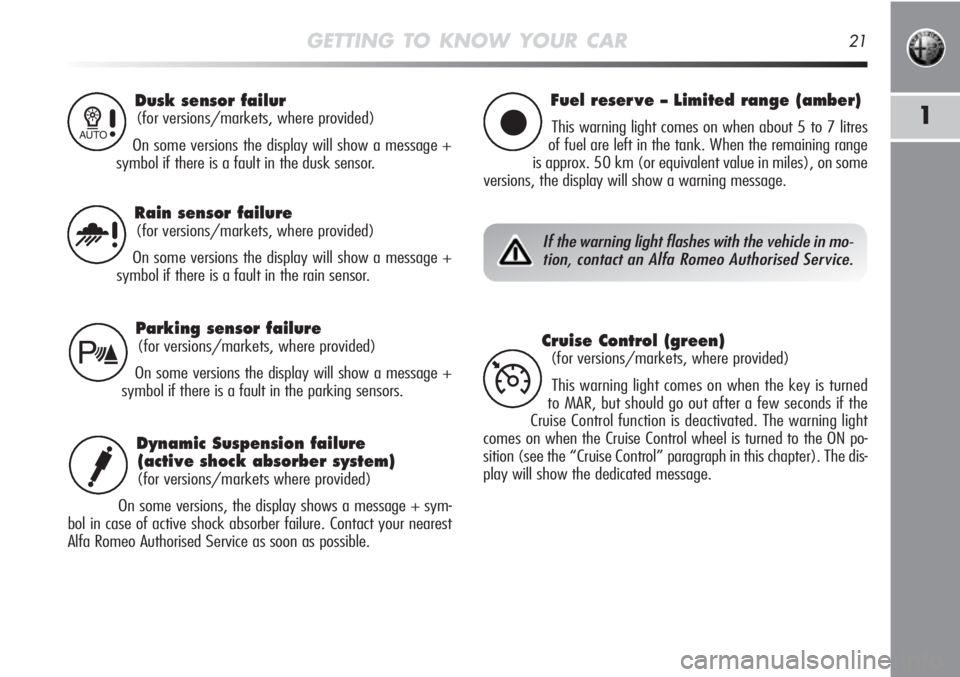
GETTING TO KNOW YOUR CAR21
1
Dusk sensor failur
(for versions/markets, where provided)
On some versions the display will show a message +
symbol if there is a fault in the dusk sensor.1
Fuel reser ve – Limited range (amber)
This warning light comes on when about 5 to 7 litres
of fuel are left in the tank. When the remaining range
is approx. 50 km (or equivalent value in miles), on some
versions, the display will show a warning message.
Parking sensor failure
(for versions/markets, where provided)
On some versions the display will show a message +
symbol if there is a fault in the parking sensors.
Rain sensor failure
(for versions/markets, where provided)
On some versions the display will show a message +
symbol if there is a fault in the rain sensor.u
ç
t
If the warning light flashes with the vehicle in mo-
tion, contact an Alfa Romeo Authorised Service.
Cruise Control (green)
(for versions/markets, where provided)
This warning light comes on when the key is turned
to MAR, but should go out after a few seconds if the
Cruise Control function is deactivated. The warning light
comes on when the Cruise Control wheel is turned to the ON po-
sition (see the “Cruise Control” paragraph in this chapter). The dis-
play will show the dedicated message.
Ü
Dynamic Suspension failure
(active shock absorber system)
(for versions/markets where provided)
On some versions, the display shows a message + sym-
bol in case of active shock absorber failure. Contact your nearest
Alfa Romeo Authorised Service as soon as possible.i
Page 111 of 262
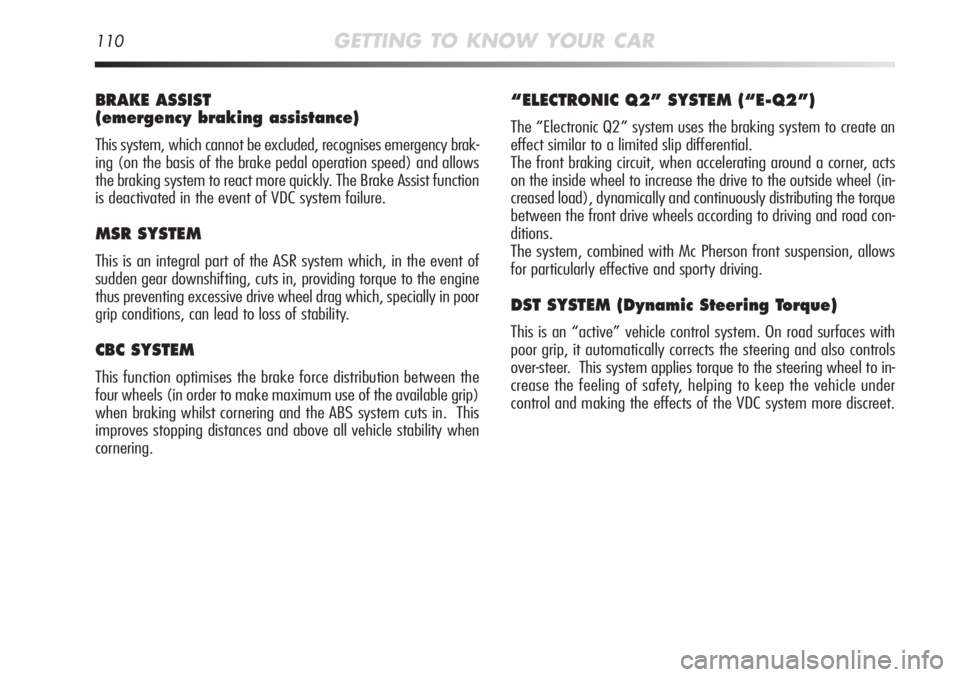
110GETTING TO KNOW YOUR CAR
BRAKE ASSIST
(emergency braking assistance)
This system, which cannot be excluded, recognises emergency brak-
ing (on the basis of the brake pedal operation speed) and allows
the braking system to react more quickly. The Brake Assist function
is deactivated in the event of VDC system failure.
MSR SYSTEM
This is an integral part of the ASR system which, in the event of
sudden gear downshifting, cuts in, providing torque to the engine
thus preventing excessive drive wheel drag which, specially in poor
grip conditions, can lead to loss of stability.
CBC SYSTEM
This function optimises the brake force distribution between the
four wheels (in order to make maximum use of the available grip)
when braking whilst cornering and the ABS system cuts in. This
improves stopping distances and above all vehicle stability when
cornering.
“ELECTRONIC Q2” SYSTEM (“E-Q2”)
The “Electronic Q2” system uses the braking system to create an
effect similar to a limited slip differential.
The front braking circuit, when accelerating around a corner, acts
on the inside wheel to increase the drive to the outside wheel (in-
creased load), dynamically and continuously distributing the torque
between the front drive wheels according to driving and road con-
ditions.
The system, combined with Mc Pherson front suspension, allows
for particularly effective and sporty driving.
DST SYSTEM (Dynamic Steering Torque)
This is an “active” vehicle control system. On road surfaces with
poor grip, it automatically corrects the steering and also controls
over-steer. This system applies torque to the steering wheel to in-
crease the feeling of safety, helping to keep the vehicle under
control and making the effects of the VDC system more discreet.
Page 120 of 262
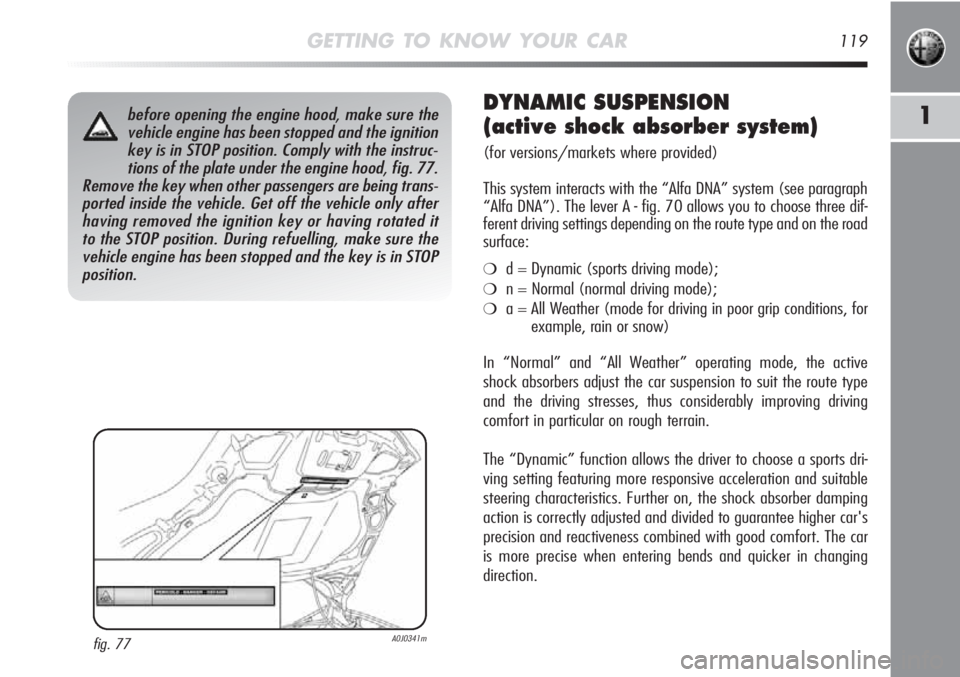
GETTING TO KNOW YOUR CAR119
1before opening the engine hood, make sure the
vehicle engine has been stopped and the ignition
key is in STOP position. Comply with the instruc-
tions of the plate under the engine hood, fig. 77.
Remove the key when other passengers are being trans-
ported inside the vehicle. Get off the vehicle only after
having removed the ignition key or having rotated it
to the STOP position. During refuelling, make sure the
vehicle engine has been stopped and the key is in STOP
position.
fig. 77A0J0341m
DYNAMIC SUSPENSION
(active shock absorber system)
(for versions/markets where provided)
This system interacts with the “Alfa DNA” system (see paragraph
“Alfa DNA”). The lever A - fig. 70 allows you to choose three dif-
ferent driving settings depending on the route type and on the road
surface:
❍d = Dynamic (sports driving mode);
❍n = Normal (normal driving mode);
❍a = All Weather (mode for driving in poor grip conditions, for
example, rain or snow)
In “Normal” and “All Weather” operating mode, the active
shock absorbers adjust the car suspension to suit the route type
and the driving stresses, thus considerably improving driving
comfort in particular on rough terrain.
The “Dynamic” function allows the driver to choose a sports dri-
ving setting featuring more responsive acceleration and suitable
steering characteristics. Further on, the shock absorber damping
action is correctly adjusted and divided to guarantee higher car's
precision and reactiveness combined with good comfort. The car
is more precise when entering bends and quicker in changing
direction.
Page 126 of 262
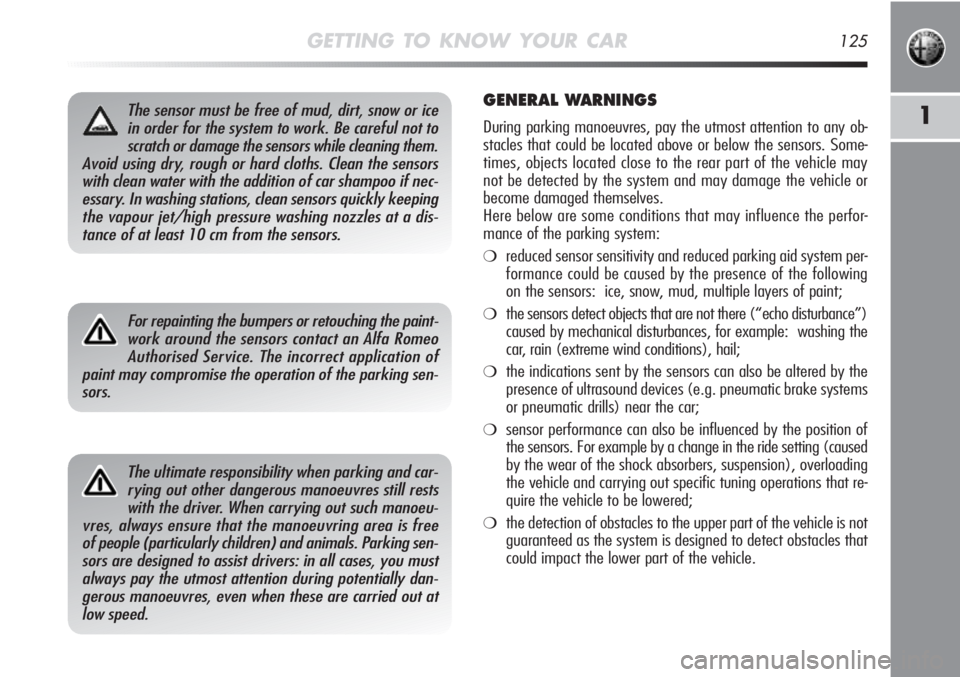
GETTING TO KNOW YOUR CAR125
1
The ultimate responsibility when parking and car-
rying out other dangerous manoeuvres still rests
with the driver. When carrying out such manoeu-
vres, always ensure that the manoeuvring area is free
of people (particularly children) and animals. Parking sen-
sors are designed to assist drivers: in all cases, you must
always pay the utmost attention during potentially dan-
gerous manoeuvres, even when these are carried out at
low speed.
GENERAL WARNINGS
During parking manoeuvres, pay the utmost attention to any ob-
stacles that could be located above or below the sensors. Some-
times, objects located close to the rear part of the vehicle may
not be detected by the system and may damage the vehicle or
become damaged themselves.
Here below are some conditions that may influence the perfor-
mance of the parking system:
❍reduced sensor sensitivity and reduced parking aid system per-
formance could be caused by the presence of the following
on the sensors: ice, snow, mud, multiple layers of paint;
❍the sensors detect objects that are not there (“echo disturbance”)
caused by mechanical disturbances, for example: washing the
car, rain (extreme wind conditions), hail;
❍the indications sent by the sensors can also be altered by the
presence of ultrasound devices (e.g. pneumatic brake systems
or pneumatic drills) near the car;
❍sensor performance can also be influenced by the position of
the sensors. For example by a change in the ride setting (caused
by the wear of the shock absorbers, suspension), overloading
the vehicle and carrying out specific tuning operations that re-
quire the vehicle to be lowered;
❍the detection of obstacles to the upper part of the vehicle is not
guaranteed as the system is designed to detect obstacles that
could impact the lower part of the vehicle.
The sensor must be free of mud, dirt, snow or ice
in order for the system to work. Be careful not to
scratch or damage the sensors while cleaning them.
Avoid using dry, rough or hard cloths. Clean the sensors
with clean water with the addition of car shampoo if nec-
essary. In washing stations, clean sensors quickly keeping
the vapour jet/high pressure washing nozzles at a dis-
tance of at least 10 cm from the sensors.
For repainting the bumpers or retouching the paint-
work around the sensors contact an Alfa Romeo
Authorised Service. The incorrect application of
paint may compromise the operation of the parking sen-
sors.
Page 127 of 262

126GETTING TO KNOW YOUR CAR
T.P.M.S. SYSTEM
(Tyre Pressure Monitoring System)
(for versions/markets, where provided)
The vehicle can be fitted with a tyre pressure monitoring system
(T.P.M.S.), which informs the driver of the tyre inflation pressure
via the “Check the tyre inflation pressure” and “Insufficient tyre in-
flation pressure” warning messages.
This system comprises of a radio frequency transmitter fitted to
each wheel (on the wheel rim inside the tyre), which is able to
send information on the tyre inflation pressure of each wheel to
the control unit.
IMPORTANT NOTES ABOUT
THE T.P.M.S. SYSTEM
The fault indications are not stored and will therefore not be dis-
played after the engine has been switched off and then on again.
If the fault conditions persist, the control unit will send fault infor-
mation to the instrument panel only after the vehicle has been in
motion for a short time.
Take the greatest of care when checking and top-
ping up the tyre inflation pressure. Excessive pres-
sure compromises road holding, increases the stress
on the suspension and wheels as well as increasing the risk
of the tyres wearing out un-evenly.
The tyre inflation pressure should be measured
with the tyres at rest and cold; if for any reason
the pressure is checked when the tyres are warm,
do not reduce the pressure if it is excessive but rather wait
until the tyres have cooled down and carry out the check
again.
The presence of the T.P.M.S. system does not mean
the driver should not carry out regular checks on
the tyre inflation pressure and spare wheel.
Should one or more wheels be fitted without sen-
sors, the display will show a warning message and
the system will no longer be available until 4
wheels fitted with sensors are fitted.
Page 194 of 262
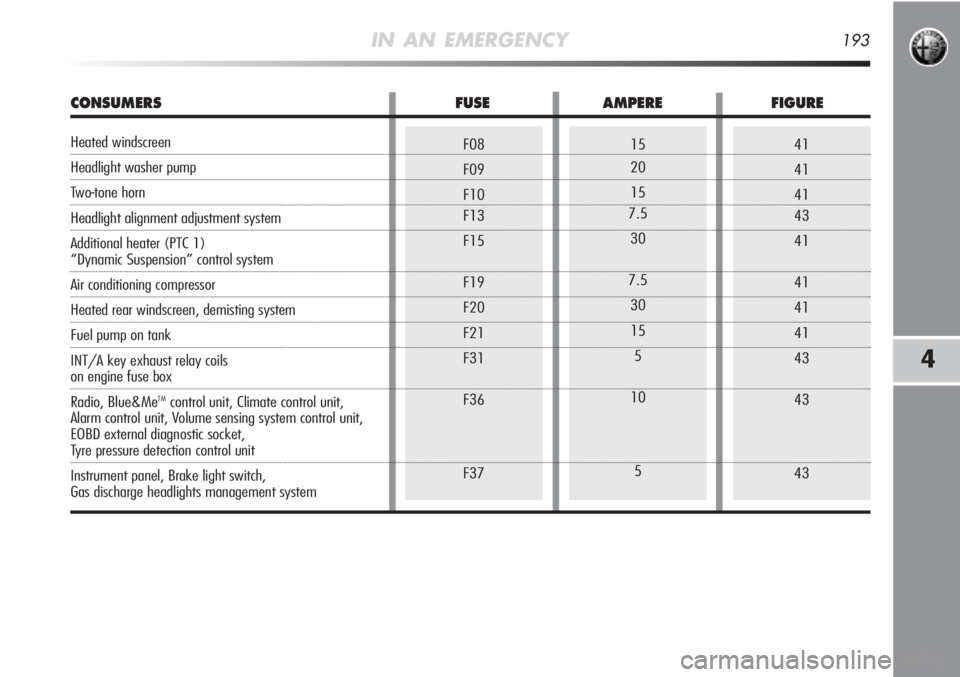
41
41
41
43
41
41
41
41
43
43
4315
20
15
7.5
30
7.5
30
15
5
10
5F08
F09
F10
F13
F15
F19
F20
F21
F31
F36
F37
IN AN EMERGENCY193
4
CONSUMERS FUSE AMPERE FIGURE
Heated windscreen
Headlight washer pump
Two-tone horn
Headlight alignment adjustment system
Additional heater (PTC 1)
“Dynamic Suspension” control system
Air conditioning compressor
Heated rear windscreen, demisting system
Fuel pump on tank
INT/A key exhaust relay coils
on engine fuse box
Radio, Blue&Me
TMcontrol unit, Climate control unit,
Alarm control unit, Volume sensing system control unit,
EOBD external diagnostic socket,
Tyre pressure detection control unit
Instrument panel, Brake light switch,
Gas discharge headlights management system
Page 228 of 262
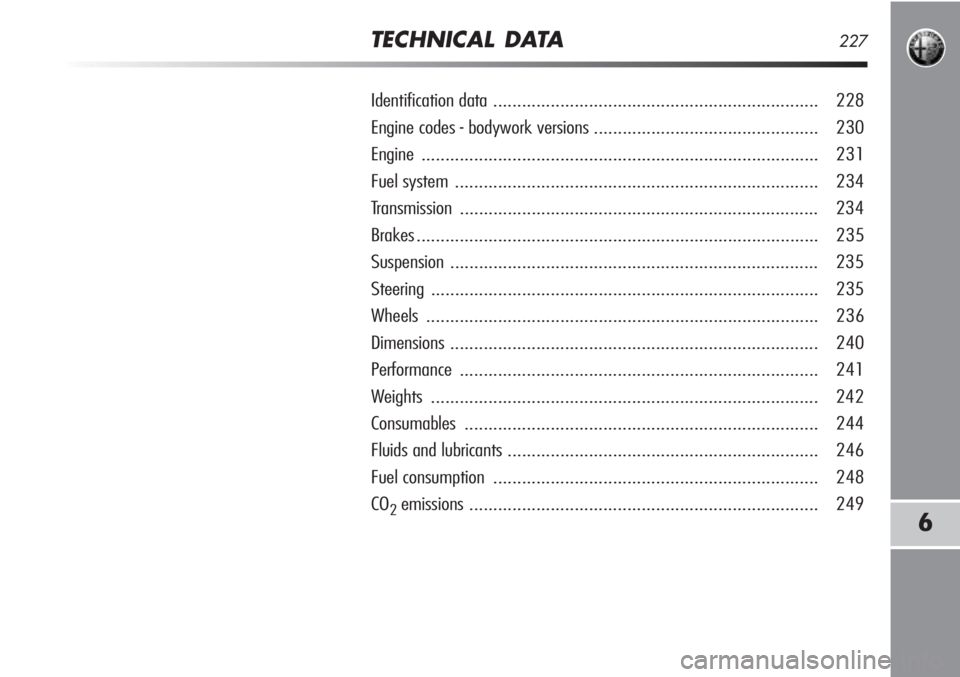
Identification data .................................................................... 228
Engine codes - bodywork versions............................................... 230
Engine................................................................................... 231
Fuel system ............................................................................ 234
Transmission ........................................................................... 234
Brakes.................................................................................... 235
Suspension ............................................................................. 235
Steering ................................................................................. 235
Wheels .................................................................................. 236
Dimensions ............................................................................. 240
Performance ........................................................................... 241
Weights ................................................................................. 242
Consumables .......................................................................... 244
Fluids and lubricants ................................................................. 246
Fuel consumption.................................................................... 248
CO
2emissions ......................................................................... 249
6
TECHNICAL DATA227
Page 236 of 262
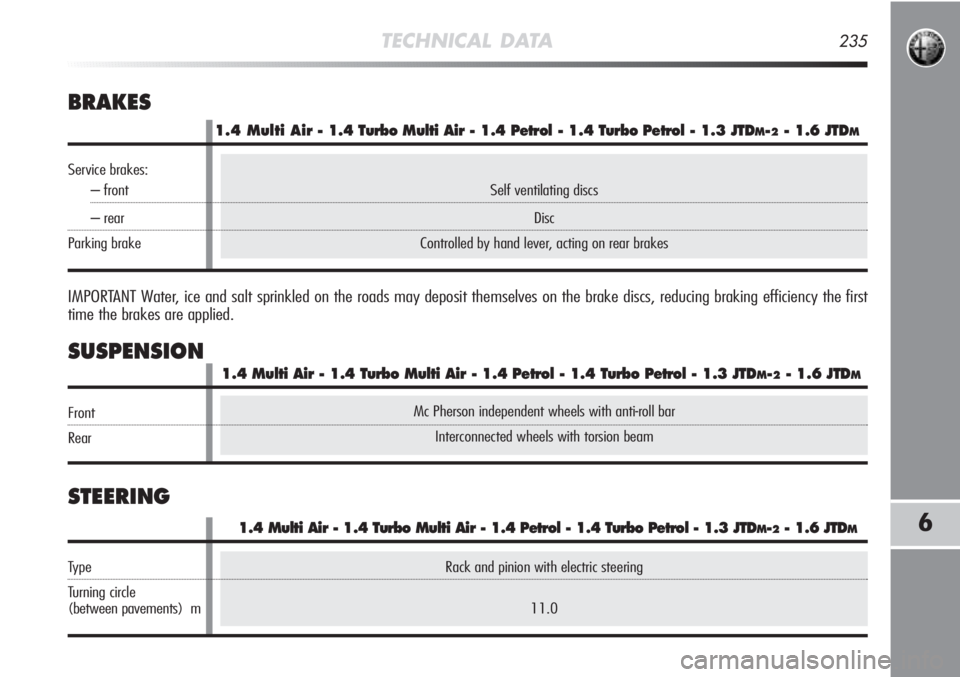
TECHNICAL DATA235
6
Rack and pinion with electric steering
11.0
STEERING
1.4 Multi Air - 1.4 Turbo Multi Air - 1.4 Petrol - 1.4 Turbo Petrol - 1.3 JTDM-2- 1.6 JTDM
Type
Turning circle
(between pavements) m
Mc Pherson independent wheels with anti-roll bar
Interconnected wheels with torsion beam
Self ventilating discs
Disc
Controlled by hand lever, acting on rear brakes
BRAKES
IMPORTANT Water, ice and salt sprinkled on the roads may deposit themselves on the brake discs, reducing braking efficiency the first
time the brakes are applied.
SUSPENSION
1.4 Multi Air - 1.4 Turbo Multi Air - 1.4 Petrol - 1.4 Turbo Petrol - 1.3 JTDM-2- 1.6 JTDM
Front
Rear
1.4 Multi Air - 1.4 Turbo Multi Air - 1.4 Petrol - 1.4 Turbo Petrol - 1.3 JTDM-2- 1.6 JTDM
Service brakes:
– front
– rear
Parking brake
Page 254 of 262
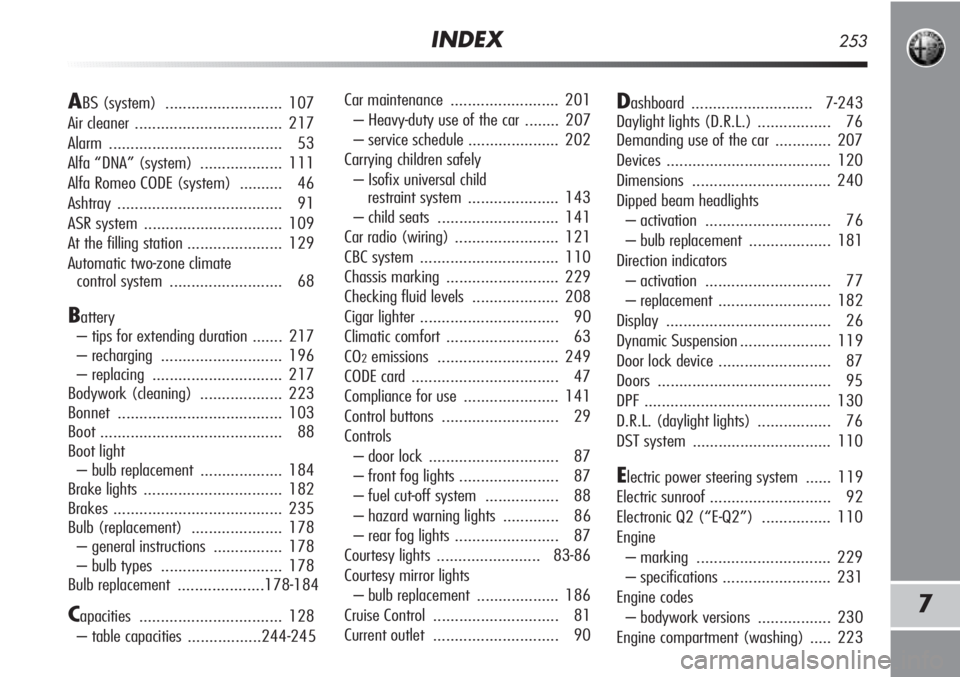
INDEX253
7
Car maintenance......................... 201
– Heavy-duty use of the car ........ 207
– service schedule ..................... 202
Carrying children safely
– Isofix universal child
restraint system ..................... 143
– child seats ............................ 141
Car radio (wiring) ........................ 121
CBC system ................................ 110
Chassis marking .......................... 229
Checking fluid levels .................... 208
Cigar lighter................................ 90
Climatic comfort .......................... 63
CO
2emissions ............................ 249
CODE card .................................. 47
Compliance for use ...................... 141
Control buttons ........................... 29
Controls
– door lock.............................. 87
– front fog lights ....................... 87
– fuel cut-off system ................. 88
– hazard warning lights ............. 86
– rear fog lights ........................ 87
Courtesy lights ........................ 83-86
Courtesy mirror lights
– bulb replacement ................... 186
Cruise Control ............................. 81
Current outlet ............................. 90
ABS (system) ........................... 107
Air cleaner.................................. 217
Alarm ........................................ 53
Alfa “DNA” (system) ................... 111
Alfa Romeo CODE (system) .......... 46
Ashtray ...................................... 91
ASR system ................................ 109
At the filling station ...................... 129
Automatic two-zone climate
control system .......................... 68
Battery
– tips for extending duration ....... 217
– recharging............................ 196
– replacing .............................. 217
Bodywork (cleaning)................... 223
Bonnet ...................................... 103
Boot .......................................... 88
Boot light
– bulb replacement ................... 184
Brake lights ................................ 182
Brakes ....................................... 235
Bulb (replacement) ..................... 178
– general instructions ................ 178
– bulb types ............................ 178
Bulb replacement....................178-184
Capacities ................................. 128
– table capacities .................244-245
Dashboard............................ 7-243
Daylight lights (D.R.L.) ................. 76
Demanding use of the car ............. 207
Devices ...................................... 120
Dimensions ................................ 240
Dipped beam headlights
– activation............................. 76
– bulb replacement ................... 181
Direction indicators
– activation............................. 77
– replacement.......................... 182
Display ...................................... 26
Dynamic Suspension..................... 119
Door lock device .......................... 87
Doors ........................................ 95
DPF ........................................... 130
D.R.L. (daylight lights) ................. 76
DST system ................................ 110
Electric power steering system ...... 119
Electric sunroof ............................ 92
Electronic Q2 (“E-Q2”) ................ 110
Engine
– marking ............................... 229
– specifications ......................... 231
Engine codes
– bodywork versions ................. 230
Engine compartment (washing) ..... 223